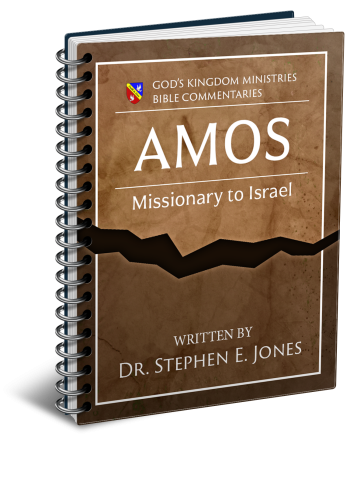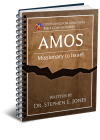Latest Posts
View the latest posts in an easy-to-read list format, with filtering options.

Amos was a missionary from Judah to Israel, giving them a final warning to repent before divine judgment was to destroy the nation. They refused, and two years later the nation was struck by a massive earthquake that destroyed their defenses and allowed the Assyrians to conquer them easily.
Category - Bible Commentaries

Amos 1:9, 10 prophesies against Tyre, saying,
9 Thus says the Lord, “For three transgressions of Tyre and for four, I will not revoke its punishment, because they delivered up an entire population to Edom and did not remember the covenant of brotherhood. 10 So I will send fire upon the wall of Tyre, and it will consume her citadels.”
The cause for divine judgment is the same as we saw earlier with Gaza, the Philistine city (Amos 1:6). Just as Gaza had engaged in slave traffic in the south, so also Tyre had engaged in slave traffic in the north of Israel. In both cases, Amos implies that they had sold many Israelites into slavery—in fact, the “entire population” of some towns or regions.
Scripture does not record these conquests, but it is certain that they were common in those days. According to biblical law, slavery was only allowed in payment of debt or as a divine judgment. Even then, God imposed some basic rules and limitations on slavery. It is clear that court-mandated slavery was not meant as a permanent condition, unless it was by the uncoerced consent of the slave.
But in those days (and even today), fleshly-minded nations sought to enrich themselves at the expense of others. For this reason, they often raided towns and nations, stealing wealth and enslaving whole populations. What seemed right to them was a matter of severe condemnation from the God of Israel.
It is clear that God held those nations accountable to His law, even though they were largely ignorant of His law. Being a non-Israelite was no excuse. The law of God is for all nations to follow.
Amos 1:9 says also that Tyre “did not remember the covenant of brotherhood.” Was there a covenant between Israel and Tyre? Yes, for it was made between Solomon and Hiram of Tyre. 1 Kings 5:12 says,
12 And the Lord gave wisdom to Solomon, just as He promised him; and there was peace between Hiram and Solomon, and the two of them made a covenant.
Amos 1:9 calls it “a covenant of brotherhood,” or a covenant of brethren. In other words, the two nations were to treat each other as brothers by not seeking to enslave each other. Other than that, we are given no details. Later, after Solomon gave Hiram a few cities in Galilee as payment for the building projects, Hiram thought that these cities were largely worthless. So we read in 1 Kings 9:13,
13 And he said, “What are these cities which you have given me, my brother?” So they were called the land of Cabul to this day.
Cabul means “binding,” in the sense of being limited or sterile. The word is related to kevel, “fetters.” So the land that Solomon gave to Hiram was quite unproductive. Hiram calls Solomon “my brother,” as if to remind him that this is not the way a brother ought to be treated. After all, Hiram had been David’s friend as well. In fact, his carpenters and stonemasons had built David’s house (2 Sam. 5:11). We know, then, that Hiram had been a long-time friend of Israel.
Solomon’s stinginess seems to have undermined the good will that Hiram felt toward Solomon, and this may have been one of the reasons that later kings of Tyre felt justified in enslaving Israelites living in the northern part of Israel. Whatever the case, the king of Tyre broke the covenant of brotherhood with Israel.
Solomon used “forced laborers” in the construction of the temple (1 Kings 5:13), overseen by Adoniram (1 Kings 5:14). Hiram himself also sent his “servants” (1 Kings 5:9) to help with the building project. Each had their own slaves, but neither enslaved the other at that time.
We are not told the circumstances of Solomon’s “forced laborers.” Were they enslaved lawfully or unlawfully? If Solomon was truly wise in those days, it seems likely that he would have used lawful slaves, those who had sold themselves to pay debts, or who had been sold by the law into slavery to pay restitution for a sin-debt.
The prophecy against Tyre was fulfilled when King Nebuchad-nezzar destroyed the city after taking the city of Jerusalem. It took thirteen years to take the city, and even then, he was unable to take the island portion of the city that lay just off the coast.
However, Ezekiel, who probably lived to see the destruction of Tyre, prophesied that the city would be razed to the ground (Ezekiel 26:4) and that it would become “a place for the spreading of nets” (Ezekiel 26:5). This was not fulfilled in the time of Nebuchadnezzar but 150 years later, when Alexander the Great conquered the island.
Alexander built a causeway from the mainland to the island, using the debris and rubble from the destroyed city on the mainland. His troops literally cast the entire city into the sea, fulfilling Ezekiel 26:4,
4 And they will destroy the walls of Tyre and break down her towers; and I will scrape her debris from her and make her a bare rock. 5 She will be a place for the spreading of nets in the midst of the sea, for I have spoken…
By using this man-made causeway, Alexander took the island city of Tyre and thereby fulfilled the rest of Ezekiel’s prophecy. Afterward, that causeway was used by fishermen to dry their nets.
As a prophetic sign, Tyre evolved into a representation of Mystery Babylon, which is also to be cast into the sea (Rev. 18:21). Both Tyre and Babylon were merchant cities, and they represent prophetically the commerce of our time that is based on the Uniform Commercial Code. This is a set of man-made laws that allow usury, perpetual debt, and a total disregard of God’s law of Jubilee.
In fact, the modern commercial system of Mystery Babylon has again delivered up an entire population (nearly the whole earth) into the hands of modern Edom, as Amos says. Although the original cities of Tyre and Babylon have long ago faded from importance, the spirit of mammon has continued to this day in new forms of economic and political slavery. For this reason, Amos’ prophecy about Tyre is still relevant to us today. Tyre has now become Babylon, the great city which will soon be destroyed.